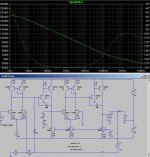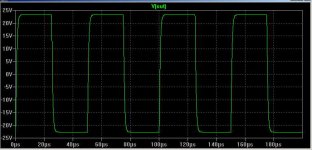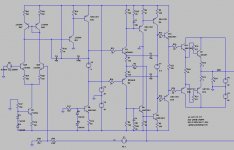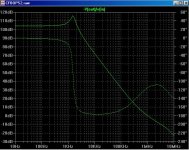Re: Re: Re: Re: CFB OPS
Hi Andy.
Will do 🙂
For now just putting some thoughts down here to clarify things in my own mind; not to lecture.
The concept here is pretty straight forward, I think. Cherry’s patent requires a bit of digestion because it discusses the implementation of multiple nested differentiating feedback loops.
Consider the simplest case here in the form of the amplifier I’ve posted, with just one loop. A typical “Linn”, “Blameless” topology is basically just one big integrator with huge voltage gain at DC, wrapping up a power output stage.
The open-loop roll-off is fixed at 20dB per decade, phase shift is 90 deg (except a little more at the unity loop gain frequency due to the finite bandwidth of the power output stage).
To add a NDFL we just throw another integrator into circuit, in series with the first one before wrapping up the power output stage. Now the roll-off is –40dB per decade and loop gain from DC to well beyond the audio band is massively increased, while the open loop phase shift approaches 180 degrees (EEKK!).
To ensure stability, phase lead (terminology ?) feedback is introduced to the 1st integrator stage to effectively cancel it out so that the loop gain roll-off reverts to a –20dB per octave slope (single intergrator) at about 1/5th the unity loop gain frequency. This ensures adequate phase margin at the unity loop gain frequency.
This characteristic can be clearly seen in the loop gain and phase plot I attached to post 2620. The unity loop gain frequency is 1MHz, with the slope reverting to –20dB / decade (1st order) at about 200kHz. Loop gain at 20kHz is greater than 50dB and she’s as stable as a rock!
Similar to TPC?
Cheers,
Glen
andy_c said:
Glen, please continue when you get the time.
Hi Andy.
Will do 🙂
For now just putting some thoughts down here to clarify things in my own mind; not to lecture.
The concept here is pretty straight forward, I think. Cherry’s patent requires a bit of digestion because it discusses the implementation of multiple nested differentiating feedback loops.
Consider the simplest case here in the form of the amplifier I’ve posted, with just one loop. A typical “Linn”, “Blameless” topology is basically just one big integrator with huge voltage gain at DC, wrapping up a power output stage.
The open-loop roll-off is fixed at 20dB per decade, phase shift is 90 deg (except a little more at the unity loop gain frequency due to the finite bandwidth of the power output stage).
To add a NDFL we just throw another integrator into circuit, in series with the first one before wrapping up the power output stage. Now the roll-off is –40dB per decade and loop gain from DC to well beyond the audio band is massively increased, while the open loop phase shift approaches 180 degrees (EEKK!).
To ensure stability, phase lead (terminology ?) feedback is introduced to the 1st integrator stage to effectively cancel it out so that the loop gain roll-off reverts to a –20dB per octave slope (single intergrator) at about 1/5th the unity loop gain frequency. This ensures adequate phase margin at the unity loop gain frequency.
This characteristic can be clearly seen in the loop gain and phase plot I attached to post 2620. The unity loop gain frequency is 1MHz, with the slope reverting to –20dB / decade (1st order) at about 200kHz. Loop gain at 20kHz is greater than 50dB and she’s as stable as a rock!
Similar to TPC?
Cheers,
Glen
Down with NDFL

I've been doing some thinking about this while shopping for my groceries. I’ve suddenly become a lot less enamoured with this whole NDFL thingie with the realisation that it is pretty much just TPC.
OK, TPC won’t give you more gain at DC, but so what? To implement TPC you do not have to add additional stages that themselves compromise linearity to a degree and require extensive elaboration to tame overload performance.
Am I on/off the plot or what?

I've been doing some thinking about this while shopping for my groceries. I’ve suddenly become a lot less enamoured with this whole NDFL thingie with the realisation that it is pretty much just TPC.
OK, TPC won’t give you more gain at DC, but so what? To implement TPC you do not have to add additional stages that themselves compromise linearity to a degree and require extensive elaboration to tame overload performance.
Am I on/off the plot or what?
Re: Down with NDFL
Hello Glenn
What do you mean by TPC ( two pole compensation?)
Regards
Arthur
G.Kleinschmidt said:
I've been doing some thinking about this while shopping for my groceries. I’ve suddenly become a lot less enamoured with this whole NDFL thingie with the realisation that it is pretty much just TPC.
OK, TPC won’t give you more gain at DC, but so what? To implement TPC you do not have to add additional stages that themselves compromise linearity to a degree and require extensive elaboration to tame overload performance.
Am I on/off the plot or what?
Hello Glenn
What do you mean by TPC ( two pole compensation?)
Regards
Arthur
Re: Down with NDFL
Indeed, there are, to a certain extent, some similarities with TPC (or TMC). Since these techniques are not mutual exclusive you can apply them both at once. How about that?
edit: See my next post for an example. 😀
G.Kleinschmidt said:
I've been doing some thinking about this while shopping for my groceries. I’ve suddenly become a lot less enamoured with this whole NDFL thingie with the realisation that it is pretty much just TPC.
OK, TPC won’t give you more gain at DC, but so what? To implement TPC you do not have to add additional stages that themselves compromise linearity to a degree and require extensive elaboration to tame overload performance.
Am I on/off the plot or what?
Indeed, there are, to a certain extent, some similarities with TPC (or TMC). Since these techniques are not mutual exclusive you can apply them both at once. How about that?
edit: See my next post for an example. 😀
Re: Re: Down with NDFL
Yup 🙂
And guess wot? I was entirely correct in my assumption. I modified (significantly simplified) my NDFL amplifier for TPC and got the same performance (with identical(ish) unity loop gain and 2pole-1pole "cross over" frequencies for a fair comparison).
Here is the TPC THD-20, 50W into 8 ohms:
Harmonic Frequency Fourier Normalized Phase Normalized
Number [Hz] Component Component [degree] Phase [deg]
1 2.000e+04 2.809e+01 1.000e+00 -0.00° 0.00°
2 4.000e+04 4.304e-05 1.532e-06 168.88° 168.89°
3 6.000e+04 7.472e-06 2.660e-07 172.03° 172.04°
4 8.000e+04 2.562e-06 9.121e-08 -26.19° -26.19°
5 1.000e+05 5.081e-06 1.809e-07 68.56° 68.56°
6 1.200e+05 1.164e-06 4.144e-08 -96.15° -96.15°
7 1.400e+05 4.318e-06 1.537e-07 79.25° 79.25°
8 1.600e+05 2.069e-06 7.364e-08 -85.13° -85.12°
9 1.800e+05 5.857e-06 2.085e-07 75.02° 75.02°
Total Harmonic Distortion: 0.000159%
OK, it is 0.4ppm higher, but I havent bothered to optimise the LTP gm/miller capacitance ratio.
Here is the schemo (note just how simple this circuit is in contrast to the performance!):
PHEONIX said:
Hello Glenn
What do you mean by TPC ( two pole compensation?)
Regards
Arthur
Yup 🙂
And guess wot? I was entirely correct in my assumption. I modified (significantly simplified) my NDFL amplifier for TPC and got the same performance (with identical(ish) unity loop gain and 2pole-1pole "cross over" frequencies for a fair comparison).
Here is the TPC THD-20, 50W into 8 ohms:
Harmonic Frequency Fourier Normalized Phase Normalized
Number [Hz] Component Component [degree] Phase [deg]
1 2.000e+04 2.809e+01 1.000e+00 -0.00° 0.00°
2 4.000e+04 4.304e-05 1.532e-06 168.88° 168.89°
3 6.000e+04 7.472e-06 2.660e-07 172.03° 172.04°
4 8.000e+04 2.562e-06 9.121e-08 -26.19° -26.19°
5 1.000e+05 5.081e-06 1.809e-07 68.56° 68.56°
6 1.200e+05 1.164e-06 4.144e-08 -96.15° -96.15°
7 1.400e+05 4.318e-06 1.537e-07 79.25° 79.25°
8 1.600e+05 2.069e-06 7.364e-08 -85.13° -85.12°
9 1.800e+05 5.857e-06 2.085e-07 75.02° 75.02°
Total Harmonic Distortion: 0.000159%
OK, it is 0.4ppm higher, but I havent bothered to optimise the LTP gm/miller capacitance ratio.
Here is the schemo (note just how simple this circuit is in contrast to the performance!):
Attachments
Re: Re: Down with NDFL
Hmmm.
I see one fine application for NDFL (especially multiple differentiating loops) - LF precision/instrumentation amplifers where huge DC gain is important and overload recovery / high speed & slew rates are unimportant.
Cheers,
Glen
Edmond Stuart said:
Indeed, there are, to a certain extent, some similarities with TPC (or TMC). Since these techniques are not mutual exclusive you can apply them both at once. How about that?
edit: See my next post for an example. 😀
Hmmm.
I see one fine application for NDFL (especially multiple differentiating loops) - LF precision/instrumentation amplifers where huge DC gain is important and overload recovery / high speed & slew rates are unimportant.
Cheers,
Glen
Re: Re: Re: Re: Re: Re: Re: CFB OPS
The NDFL stage has issues.
Have a look at this two years old post:
http://www.diyaudio.com/forums/showthread.php?postid=1170908#post1170908
Basically, it's a blameless amp and that 'funky Rush' stage is replaced by only one additional tranny. The circuit also combines NDFL with TMC.
Notice that the overload recovery is lousy, as I didn't spend much time on that issue then.
And here a cookbook recipe for (even better) R and C values:
http://home.tiscali.nl/data.odyssey/PGP.html
Only the first part (fig. 1 and 2) might be of interest, as the rest is PGP amp specific.
G.Kleinschmidt said:NO!. There are no overload recovery issues with a miller cap connected as feedback around a VAS. As far as that stage goes, all you need is a voltage clamp on the VAS collector.
The NDFL stage has issues.
I've got a few ideas for replacing that funky Rush current amplifier stage.
...............
Cheers,
Glen
Have a look at this two years old post:
http://www.diyaudio.com/forums/showthread.php?postid=1170908#post1170908
Basically, it's a blameless amp and that 'funky Rush' stage is replaced by only one additional tranny. The circuit also combines NDFL with TMC.
Notice that the overload recovery is lousy, as I didn't spend much time on that issue then.
And here a cookbook recipe for (even better) R and C values:
http://home.tiscali.nl/data.odyssey/PGP.html
Only the first part (fig. 1 and 2) might be of interest, as the rest is PGP amp specific.
Re: Re: Re: Down with NDFL
Hence Prof. Huijsing's numerous papers. Our module guys used one version of this trick (op-amp cascade) back in the 70's.
I wish this stuff worked at 100MHz.
G.Kleinschmidt said:
Hmmm.
I see one fine application for NDFL (especially multiple differentiating loops) - LF precision/instrumentation amplifers where huge DC gain is important and overload recovery / high speed & slew rates are unimportant.
Cheers,
Glen
Hence Prof. Huijsing's numerous papers. Our module guys used one version of this trick (op-amp cascade) back in the 70's.
I wish this stuff worked at 100MHz.
Re: Re: Re: Re: Re: Re: Re: Re: CFB OPS
OK, thanks. 2.2ppm at 30W / 4 ohms 100kHz BW, with NDFL combined TMC.
Here is what I get at 30W with NDFL and CFB (the TPC + CFB version would be about the same):
Harmonic Frequency Fourier Normalized Phase Normalized
Number [Hz] Component Component [degree] Phase [deg]
1 2.000e+04 2.188e+01 1.000e+00 -2.30° 0.00°
2 4.000e+04 1.325e-05 6.058e-07 95.01° 97.31°
3 6.000e+04 5.756e-06 2.631e-07 -149.10° -146.80°
4 8.000e+04 1.518e-06 6.940e-08 -92.74° -90.44°
5 1.000e+05 8.109e-06 3.706e-07 58.58° 60.88°
Total Harmonic Distortion: 0.000076%
On a more serious note, I'm really not sure that NDFL is really worth all the hassle just for breaking the 1ppm barrier.
Cheers,
Glen
Edmond Stuart said:
The NDFL stage has issues.
Have a look at this two years old post:
http://www.diyaudio.com/forums/showthread.php?postid=1170908#post1170908
Basically, it's a blameless amp and that 'funky Rush' stage is replaced by only one additional tranny. The circuit also combines NDFL with TMC.
Notice that the overload recovery is lousy, as I didn't spend much time on that issue then.
And here a cookbook recipe for (even better) R and C values:
http://home.tiscali.nl/data.odyssey/PGP.html
Only the first part (fig. 1 and 2) might be of interest, as the rest is PGP amp specific.
OK, thanks. 2.2ppm at 30W / 4 ohms 100kHz BW, with NDFL combined TMC.
Here is what I get at 30W with NDFL and CFB (the TPC + CFB version would be about the same):
Harmonic Frequency Fourier Normalized Phase Normalized
Number [Hz] Component Component [degree] Phase [deg]
1 2.000e+04 2.188e+01 1.000e+00 -2.30° 0.00°
2 4.000e+04 1.325e-05 6.058e-07 95.01° 97.31°
3 6.000e+04 5.756e-06 2.631e-07 -149.10° -146.80°
4 8.000e+04 1.518e-06 6.940e-08 -92.74° -90.44°
5 1.000e+05 8.109e-06 3.706e-07 58.58° 60.88°
Total Harmonic Distortion: 0.000076%

On a more serious note, I'm really not sure that NDFL is really worth all the hassle just for breaking the 1ppm barrier.
Cheers,
Glen
Re: Re: Re: Re: Down with NDFL
Beyond a point wouldn't input offset currents / voltages eventually stop one from any substantial gains?
scott wurcer said:
Hence Prof. Huijsing's numerous papers. Our module guys used one version of this trick (op-amp cascade) back in the 70's.
I wish this stuff worked at 100MHz.
Beyond a point wouldn't input offset currents / voltages eventually stop one from any substantial gains?

wot
 ???
???You are supposed to look at the way I have circumvented that 'funky Rush' thingy instead of looking at THD, that always can be made better.
But if you prefer a THD contest, then here's my latest figure at 20kHz and 200W: 50ppb

edit:
>On a more serious note, I'm really not sure that NDFL is really worth all the hassle just for breaking the 1ppm barrier.
Agreed. That's why I follow a different line by now.
Re: Down with NDFL
And so is TMC or any other three letter acronym 🙂 They all rely on the simple fact that all you need is steep rolloff and proper phase at ULG. So the idea is to insert N poles to get steep roloff then N-1 zeroes to bring the phase back. And space them properly so they don't walk erratically when you close the loop (see the "1/5 ULG rule" in NDFL and the 5:1 cap ratio in TPC).
G.Kleinschmidt said:I've been doing some thinking about this while shopping for my groceries. I?ve suddenly become a lot less enamoured with this whole NDFL thingie with the realisation that it is pretty much just TPC.
And so is TMC or any other three letter acronym 🙂 They all rely on the simple fact that all you need is steep rolloff and proper phase at ULG. So the idea is to insert N poles to get steep roloff then N-1 zeroes to bring the phase back. And space them properly so they don't walk erratically when you close the loop (see the "1/5 ULG rule" in NDFL and the 5:1 cap ratio in TPC).
G.Kleinschmidt said:So wot is this whole PGP thingie then?
I was already expecting this question. 😀
The front-end of the PGP amp stems from ideas I had a couple of years ago, which by now are superseded by TMC and the CFB OPS. Just call it progress. Besides, syn08 never believed in TMC, so that was one more reason to use something else, i.e. NDFL.
Re: Re: Down with NDFL
Right. Concise too.
syn08 said:And so is TMC or any other three letter acronym 🙂 They all rely on the simple fact that all you need is steep rolloff and proper phase at ULG. So the idea is to insert N poles to get steep roloff then N-1 zeroes to bring the phase back. And space them properly so they don't walk erratically when you close the loop (see the "1/5 ULG rule" in NDFL and the 5:1 cap ratio in TPC).
Right. Concise too.

Re: Re: Down with NDFL
Er, no, that is a bit of an over-simplification. There are distinct pro's and con's to each. TMC is in fact significantly different becuse it only reduces the distortion of the OPS - TPC the whole amplifier.
NDFL is closer to TPC than TMC in this regard (for example, in our amps here, the NDF loop encloses everything besides the input stage (the LTP).
Cheers,
Glen
EDIT:
For example TMC can be entirely ineffective (as opposed to TPC) if the OPS (for example) non-linearity is not dominant over the non-linearity of the preceding stages (totally innocent example).
syn08 said:
And so is TMC or any other three letter acronym 🙂 They all rely on the simple fact that all you need is steep rolloff and proper phase at ULG. So the idea is to insert N poles to get steep roloff then N-1 zeroes to bring the phase back. And space them properly so they don't walk erratically when you close the loop (see the "1/5 ULG rule" in NDFL and the 5:1 cap ratio in TPC).
Er, no, that is a bit of an over-simplification. There are distinct pro's and con's to each. TMC is in fact significantly different becuse it only reduces the distortion of the OPS - TPC the whole amplifier.
NDFL is closer to TPC than TMC in this regard (for example, in our amps here, the NDF loop encloses everything besides the input stage (the LTP).
Cheers,
Glen
EDIT:
For example TMC can be entirely ineffective (as opposed to TPC) if the OPS (for example) non-linearity is not dominant over the non-linearity of the preceding stages (totally innocent example).
Re: Re: Re: Down with NDFL
Er, no. TPC, TMC, NDFL, etc... they don't reduce any distortion per se. They just allow more loop gain (local and/or global) to allow the negative feedback to do it's job. The rest is irrelevant.
G.Kleinschmidt said:Er, no, that is a bit of an over-simplification. There are distinct pro's and con's to each. TMC is in fact significantly different becuse it only reduces the distortion of the OPS - TPC the whole amplifier.
Er, no. TPC, TMC, NDFL, etc... they don't reduce any distortion per se. They just allow more loop gain (local and/or global) to allow the negative feedback to do it's job. The rest is irrelevant.
- Home
- Amplifiers
- Solid State
- Bob Cordell Interview: Negative Feedback



